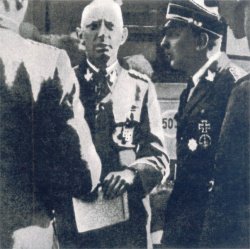
Gen. Reinefarth with its staff in Wola District
The Wola massacre
The Warsaw Uprising was a surprise to a large part of Warsaw society, including the population of Wola District. However, the joy during the first hours was enormous and spontaneous.
People, tired of occupant's tyranny, were now expecting a quick end to the nightmare that had lasted for five years.
What happened in Wola District in the next days of the Uprising was beyond all imagination...
German death squads entered the district from the side of west borders of the city and were heading in the direction of Srodmiescie District, "cutting out" all what lived, demolishing and burning all the infrastructure.
The slaughter of Wola District was performed on the innocent people, who were dragged out of their homes with the whole families. There were the sick, children and babies among them.
The massacre took place in yards, bigger squares, streets..., where people were being killed with side arms, machine guns mounted on a platform on the ground, grenades, and even a tank cannon, which people in the corner of Wolska and Elekcyjna streets were killed with.
Civil population was murdered home after home, street after street... This holocaust was done during a few days, but reached its climax on the 5th and 6th of August, 1944. When the killing ended, houses would be set on fire. There were many cases of burning people alive in such houses by not letting them to get out.
Some part of population were destined to die in a different manner - they were forced to become "human barricades" and "human shields" in order to protect German soldiers while they were attacking the insurgent barricades. Since August 4th Germans introduced into action diving bombers, which were ceaselessly bombing the district.
Wola died - its population was murdered in torments and its houses were burned. It is estimated that around 50 000 people were murdered. It was the unprecedented genocide of helpless civil population. In a few days two times more people were killed here than in Katyn, Kharkov and Miednoje.
After the outbreak of the Warsaw Uprising on August 1st, 1944, the first strong German blow was directed on two west districts of Warsaw: Wola and Ochota. Germans wanted to secure for the army from the west the communication trail to bridges across Vistula River, to Praga District and further to the east.
Since the first days of the uprising the attacking Germans were following the Hitler's and Himmler's order which said: "kill every citizen, do not take prisoners". This directive was carried out ruthlessly.
After forcing the insurgents from the positions in the west side of Wola, Germans immediately started killing the civil population, burning houses, often with people inside. When on August 3rd and 4th, 1944, German reinforcements from the area of Poznan came to Warsaw, these actions were intensified.
On August 5th German forces began a general attack on Wola, the first district of Warsaw on their way. Faced with the overwhelming supremacy of the enemy who had tanks, artillery, an armored train and air force at his disposal, the guerrilla soldiers were forced to retreat from a part of the district in the east direction, in the direction of central districts.
In the area captured by Germans, on August 5th started the unprecedented massacre of civil population. Death roller was rolling from the west borders of Wola along Wolska and Gorczewska streets. Death squadrons were being supplied by special armored vehicles with ammo and replacement barrels to machine guns. The massacre was being supervised from the commanding position near Wolska and Syreny streets by the executor of Wola Gen. Heinz Reinefarth.

Gen. Reinefarth with its staff in Wola District
Jerzy Jankowski, who in August, 1944, was 12 years old recalls:
"The uprising in Warsaw continued... It was a beautiful summer. A warm, early morning of August 5th, 1944, did not indicate the sentence issued on our district. It was the fifth day of the Warsaw Uprising. Wola was burning, wreaths of smoke and odor of burning bodies was lingering in the air, fear and gloom reigned everywhere. Germans brought reinforcements in form of men and equipment from so called Warta state - Poznan. The sounds of the series of machine gun fire, single shots and exploding grenades could be heard all the time. By the Himmler's order, the units of German "relief" under the command of SS - Gruppenführer Heinz Reinefarth and a brigade of professional German criminals under the command of SS - Oberführer Oskar Dirlewanger entered the suburbs of Wola. Covered by tanks and armored vehicles, a violent attack on the city from the west began. Its main trail to Srodmiescie District was Wolska street.
In front of a house in Sowinskiego street in Wola which we were living in appeared a storm unit in German uniforms with ammo belts and grenades. They were German units and their allies: Russians and Ukrainians. The sight was fearsome. The fear paralyzed the movements and took the breath away. Over a dozen of soldiers run into the building and looted the flats from what could. The fear we felt is impossible to describe. All of a sudden shots were fired and shouts in both languages were heard: "raus", "wychodzitie skorej", "schnell". All the people living in our house of flats ran to the exit, where they were again given orders: "hände hoch", "ruki wierch", "pod stienku".
By the wall of the house from the side of the street a line was formed, with the people facing the wall and holding hands in the air. In this line, consisting of the neighbors, stood our mother with two younger children (10 and 12 years old).
A few meters away from us stood Storm Unit with submachine guns in their hands. People started to whimper: "mercy". The horror increased. For a moment there was silence, only the clang of ammo being reloaded could be heard. Soon, all was about to end.
In this breaking moment between life and death, a miracle happened. From the side of Grodziska street two Germans were running, shooting in the air to show that they wanted something. After reaching the place, it turned out that they were two German officers from Wehrmacht and Bahnschutz. One of them was the commandant of the railway post, which had existed for a few years of occupation near railway siding not far from our house.
After dramatic negotiations with the Storm Unit, which seemed to last forever, and unknown to us arguments of the officers, the execution was aborted. We were saved! As we learned later it was thanks to a neighbor from the upper floor, who knew German language and who, seeing the dramatic way the situation had been developing, had run as fast as she could to beg them for help, thus saving us from the inevitable death."
In such dramatic circumstances the family of Jankowski managed to leave Wola and reach the nearby Wlochy district. They survived from the massacre. However, most of the population of the district had less luck. The testimony given by the few number of survivors presents a gruesome description of the tragedy.
Executions were of mass and organized nature. They were accompanied by bestialities and rapes. The old people, children, women, doctors, priests - no one was spared. The advancing German units were leaving behind the bodies of thousands of murdered. Crimes took place in almost every house, factory or park in Wola, in most of streets, in yards and gateways. Houses were looted and burned.
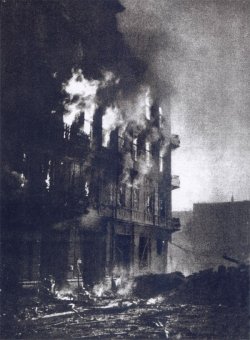 |
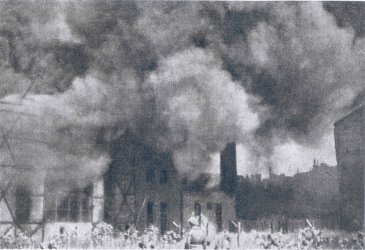 |
burning Wola
Murderers were advancing systematically deeper into the district. The relations from crime places mentioned in the text are the testimonies of direct witnesses given before the Commission for the Prosecution of Hitler's Crimes in Poland [pl. Komisja Badania Zbrodni Niemieckich w Polsce].
In the premises of the orthodox church of St. Jan Klimak in Wolska street Germans committed an exceptionally inhuman crime on orphan children from the Orthodox Orphanage at 149 Wolska street.
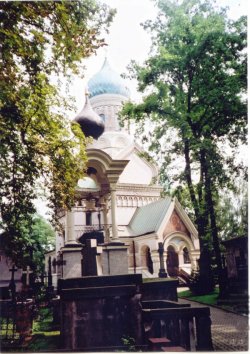 Wola orthodox church [cerkiew wolska] (fot. J. Mankowska) |
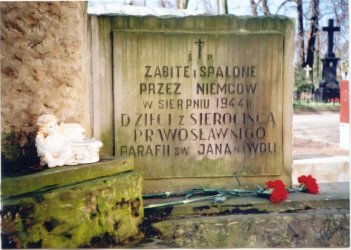 memorial plaque dedicated to the murdered children (fot. J. Mankowska) |
They killed also other people who had been seeking shelter in the orthodox church. The witness of the crime, 12-years old girl Marysia Cyranska testifies:
"We were ordered to leave (from the smaller orthodox church) to the Wolska street. Here, I spotted machine guns set on the railway tracks. We were led to a ditch near the fence. We were ordered to get into the ditch and then a series was fired...
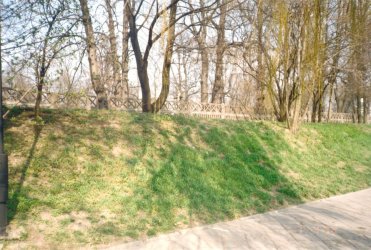
embankment near the Orthodox Cemetery (fot. J. Mankowska)
They were shooting with a machine gun and small arms. When all fell down, the shooting ended. I fell down, hit in the left arm. A shrapnel hit me in the temple and cheek. When I was lying, I noticed that an unknown man moved and was killed off by them. After checking that everyone were dead, the Germans went away. Then I got up and started to call... No one answered. Then I went through the Orthodox Cemetery to the house at 15 Elekcyjna street. When I got there, all the residents were at home, including grandmother, aunt Helena Cyranska and uncle Stanislaw Cyranski.
At the same time a man living in the Hankiewicz's house at 129 Wolska street came and told about the execution that took place that day. Then uncle and that man decided to go to the place of execution in order to help the wounded. I saw that when they got to the top of the embankment of the orthodox cemetery, they encountered German soldiers who shot both of them. I stayed with grandmother and aunt Helena, we hid in the garden near the house.
On the next day, August 6th, aunt and grandmother heard a conversation in the house and went in the direction of those voices. They were the Germans who shot them. When I saw this I ran away through the cemetery...
I was caught by two Ukrainian soldiers. One of them wanted to shoot me, but the other objected to that. They let me go. I went to Wola Hospital [Szpital Wolski]... Apart from me there was a homeless boy, who survived from the same execution (his parents were killed near the the orthodox church). His surname was Kepinski."
Parents of the girl died in the massacre. Wieslaw Kepinski, who survived, ran away before bullets reached him. He wrote a book about this crime, under the title "Szescdziesiaty pierwszy" ["Sixty-first"]. Out of all the children from the orphanage two girls managed to survive; they had hidden in a cemetery tomb.
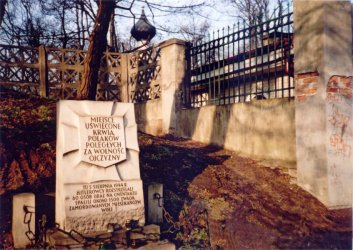
memorial plaque dedicated to the people murdered by the fence of the orthodox church (fot. J. Mankowska)
Professor Hans Thieme who served in Wehrmacht described his feelings about this place in the following manner:
"We experienced the first more direct impression about that place in Wolska street, before entering the city. In the middle of the cemetery stood an orthodox church, quite modern, massively constructed and beautifully adorned... Several citizens hid themselves - women, men, the old and children - in the basements, taking the most precious things they had. Looted suitcases, clothes, beds and other things were lying in all parts of the basement... And where were the people?
I left the basement... walked around the church and reached one of the tombs. People were there! These miserable and apparently completely innocent people who dared to hide in the house of God were taken here to the cemetery and executed - men, women, the old and children - all of them. Swarms of flies were moving around them, while they were lying in the puddles of blood, waiting until some slaughterer or minions would bury them... During the first days of the uprising During the first days of the uprising by the personal order of Hitler all that was Polish was executed, regardless of the age or sex."
The battalion of Oskar Dirlewanger, which consisted of criminals, was infamous for its exceptional cruelness. Its trail was marked by places of execution, one after another. Waclawa Szlacheta, who was 43 years old back then, tells about the crime in the area of the Sowinskiego Park from the side of Wolska street:
"On August 5th, 1944, at 10 a.m. in the yard of our home at 129 stormed a German unit. There were a few dozens of them. They were armed in hand machine guns and grenades. The house was large, consisted of over 150 flats and had about 600 tenants... A few bed-ridden stayed inside. I walked out from the flat with my husband, two sons and two daughters. Together with other tenants we were ordered by the gendarmerie to get out to Wolska street, cross the street and stop near the Gen. Jozef Sowinski Park [Park im. Gen. Jozefa Sowinskiego]. Men were separated from women and mothers from the sons older than 14 years. We were grouped near the fence of the park, from the park's gate... up to the place where the stone cross stands.
As I was standing by the fence I saw that on the corner of Wolska and Ordona streets there was a machine gun on a platform, and near our house, about 10 meters from Ordona street in the direction of Pradzynskiego street there was a second one. I saw also the third one, but I do not remember now, where it was (it was closer to Pradzynskiego street). With those machine guns German soldiers shot series into us... I fell to the ground. I was not wounded. Corpses were falling down on my legs. My youngest daughter, Alina who was lying next to me was still alive.
As I was lying, I saw and heard how German soldiers were walking between the lying and kicking them to check who was still alive. Those who were alive were killed with single shot of a revolver... I saw how a soldier came close to the baby cart, where several-months-old twins of my neighbor Jakubczyk were lying and shot them. All the time I heard the moans of the dying... I did not see the bodies of the husband and sons, when I was leaving the place of execution, but there was no news about them. I saw the bodies of both daughters... "
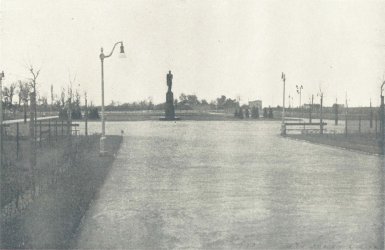 Gen. Jozef Sowinski Park |
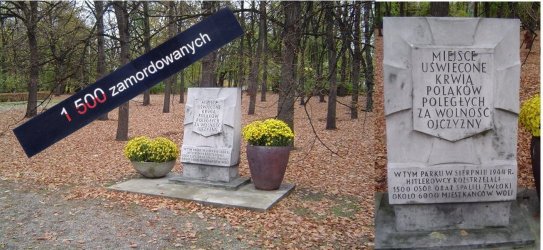 memorial plaque in Gen. Jozef Sowinski Park (fot. M. Janaszek-Seydlitz) |
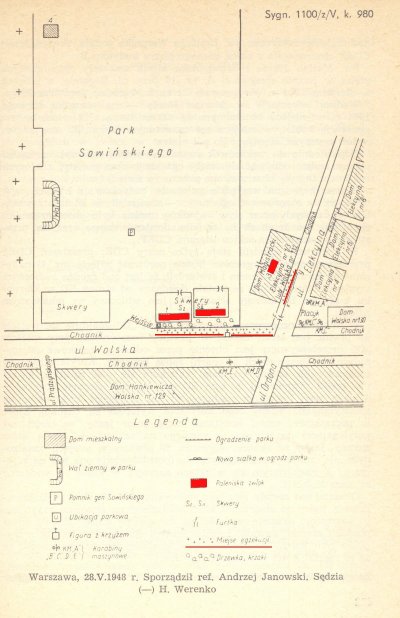
the sketch of the place of execution in Gen. Jozef Sowinski Park
After capturing Wola Germans arranged in the Gen. Jozef Sowinski Park the position of the heaviest self-propelled siege mortar "Karl-Gerät". From there, on August 16th, 1944, they started to shell Warsaw with huge projectiles which weighted 2200kg. The soldiers operating the monster were not concerned at all that in their direct vicinity rested the ashes of thousands of murdered and burned the citizens of Wola.
On "black Saturday" of August 5th death sowers worked without rest. Jan Grabowski, who survived the massacre near the blacksmith's at 124 Wolska street, testifies:
"... on August 5th, 1944, around 100 German military policemen stormed into the yard of our home at 123 Wolska street and formed a line up to the blacksmith's, which was located deeper into 124 Wolska street, almost opposite our home... I went out together with my wife Franciszka, 4-year-old daughter Irena and 5-month-old son Zdzislaw Jerzy In the square in front of the blacksmith's all were ordered to lie down on the ground. The group from our house numbered about 500 people. When I got there with my family, people had already been lying on the square.
When I was lying, I saw that there is a machine gun mounted on a platform... at the distance of about 5-10 meters. The Germans started to shoot with the machine gun and rifles, and also to throw grenades in the crowd of lying people... After some time the shooting was over and I saw that the Germans brought another group of people... the shooting and breaks for finishing off those still living lasted at least 6 hours... A military policeman walked three times over me, I was not injured, but my wife and children were murdered. I heard a military policeman ordering to kill my 5-month-old son, who was crying, then I heard a shot and the child got silent... I was playing dead... When workers who were carrying corpses came to take also me, I got up and started to carry the dead with them, until the end of the work. We were putting them on two piles... until the dusk. One was about 20 m long and the other 15m, about 10 m wide and about 1.5 m tall... The military police were still accompanying the workers and killing those who survived..."
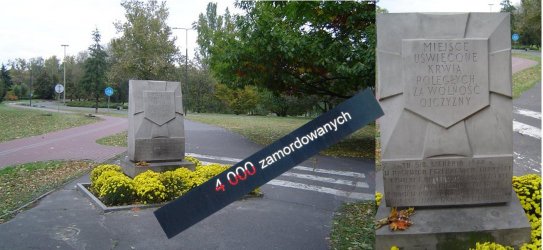
memorial plaque in a place of execution (fot. M. Janaszek-Seydlitz)
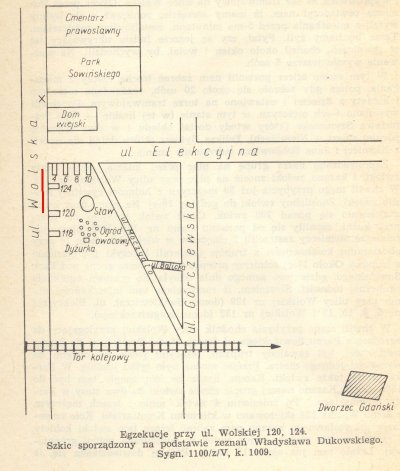
the sketch of the places of executions
Witness Jakubowska gave relation about the massacre in Wawelberg's colony at 15 Gorczewska street:
"On August 7th, 1944, at 9 a.m., 15 Gorczewska street. Three 4-storey Wawelberg's blocks of flats are surrounded by the Germans from the SS. They throw grenades inside, machine guns are placed all around; no one is let out; they set the house on fire from every side; when someone gets out, there are killed; burned throw themselves from windows, no one can get out of the flame, they are burning alive, only a miracle could help someone leave that place; I know about a woman who jumped through a window from the second floor and survived; the exit is full of the bodies of those who tried to run away from the flames; I saw a woman with a child by her breast among them.
Houses were surrounded from all sides. I suppose that there might have been up to 2 000 (two thousand) people in these buildings. No one alive got out of there, except for a miraculous way like the abovementioned woman."
Horrifying relation was presented by Wanda Felicja Lurie, 33 years, domiciled in 18 Wawelberga street, called later the Polish Niobe:
"... Until August 5th, 1944, I staying with my three children, who were 11, 6, and 3.5 years old, in the basement of the house at 18 Wawelberga street. I was in the last month of pregnancy. Around 12 o'clock Germans entered the yard, ordering people to leave the basements. Shortly after they started to throw incendiary grenades there... At 55 Wolska street, in front of "Ursus" factory 500 people were gathered... After an hour I was taken inside with a group of people. In the yard I saw piles of bodies up to 1m tall... In my group there was a lot of children in the age of 10-12, often without parents...
I begged the surrounding us Germans to save the children and me. One of them asked if I had something to bail out. I gave him 3 golden rings. He took them, but the officer supervising the execution ordered to join me to the group that was going to be shot... He pushed me so hard that I fell down. He saw I was in the last month of pregnancy. Then he punched my older son shouting: Faster, you Polish bandit!... The children were walking crying... At one moment slaughterer who was standing behind me shot my older son in the back of his head, next shots hit my younger children. Then they shot me. I fell down on the left side. The bullet hit my neck and went through the lower part of the skull, going out through the right cheek. I got pregnancy hemorrhage, and lost a few teeth.
I was awake and I saw everything while lying among the dead bodies... It was after it got dark that the executions stopped. The executors were walking among the bodies, kicking and flipping them over, killing the living, and robbing... I was lying three days among the dead. On the third day I felt that the child whom I was expecting is alive. It gave me strength and made me think about saving myself... After many attempts I got out to Skierniewicka street. I joined a small group of people. We were caught by Ukrainians and taken to St. Wojciech's Church... After two days I was transported on a cart to the transit camp in Pruszkow, and from there to hospitals in Komorow and Lesna Podkowa... On August 20th I gave birth to a boy..."
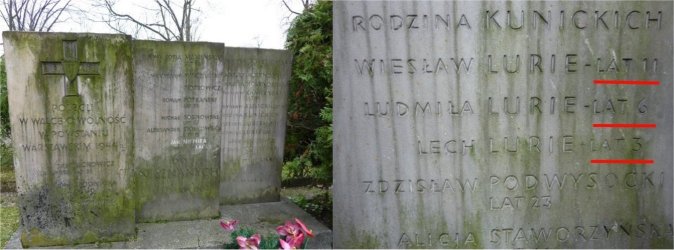
memorial plaque on the grave of Lurie's children in the Warsaw Insurgents Cemetery (fot. M. Janaszek-Seydlitz)
The son of Wanda Lurie is alive, he is doctor of chemistry sciences. He is constantly fighting so that the memory of his Mother and thousands of other Wola dwellers would not be lost. In "Ursus" factory, one of the biggest executions, Germans murdered about 7000 people from nearby houses.
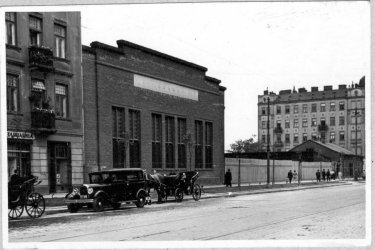 Ursus" factory, 55/57 Wolska street |
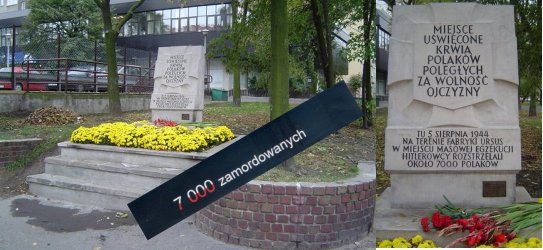 memorial plaque dedicated to the people murdered in the "Ursus" factory (fot. M. Janaszek-Seydlitz) |
German murderers did not spare the hospitals in Wola. There were four hospitals situated not far from each other in the area of Wolska, Plocka, Zytnia, and Karolkowa streets: Wolski Hospital, Karol and Maria Hospital, St. Lazarus Hospital, and St. Stanislaw.
In the Wolski Hospital at 26 Plocka street, which had 480 beds, there were some wounded and many civilians looking for shelter. At noon on August 5th Wehrmacht soldiers warned doctor Jozef Piasecki that SS units were coming. Around 2 p.m. the SS soldiers from Reinefarth's group entered the hospital. They shot doctor Piasecki, professor Janusz Zeyland und hospital chaplain priest Kazimierz Ciecierski. The remaining personnel and most of the sick and wounded were driven to factory buildings in Moczydlo sub-district. After separating women, all men, almost 400 people, were shot in the mass-execution.
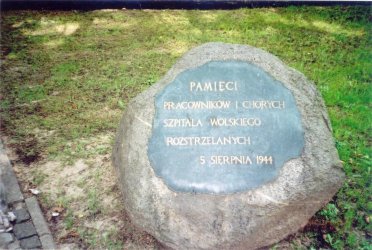
memorial plaque by the Wolski Hospital (fot. J. Mankowska)
Priest doctor Bernard Filipiuk, 46, who survived the execution in Gorczewska street (where 12.000 people were shot):
"... On August 5th, 1944, the Germans came to the Wolski Hospital again, this time in a bigger number. There were Ukrainians and Georgians among them. Around 1 p.m. a German officer together with two SS soldiers entered the office of the hospital's director, doctor M. Piasecki, who were accompanied by professor doctor J. Zeyland and a priest (K. Ciecierski), the hospital's chaplain. The officer shot them. Right after this murder one of the doctors told me that. Then the Germans spread out in the whole hospital and were throwing the sick from their beds, threatening them with rifles... I was after the operation of stomach. A German hit me and pushed out of the bed on the corridor. I was wearing only pajamas and was barefoot.
In front of the hospital there was already a long queue of men grouped in fours: the sick, doctors, nurses, and people who were looking for shelter in the hospital... We were led through Plocka and Gorczewska streets in the direction of district railway... We were brought to the yard of a factory... People were taken in groups, at first the healthy ones, then the sick... We were lined in fours, in groups of 12 people. They took our watches and... we were sure that we are going to die. At that time I was already wearing a cassock brought by a Daughters of Charity nun... The place of execution was a large yard. I was standing there for about 15-20 minutes. I saw how every group of 12 men was executed by shooting in the back.
Waiting for the death, father Jerzy Zychon, missionary from Cracow, who was one of the sick in the Wolski Hospital, granted the general absolution to everybody, and I gave it him. Then we recited the Lord's Prayer aloud. When we were saying last words, a Gestapo soldier shouted "Move"! I heard the German word for "Fire". A series was fired, and I fell down together with father Zychon, who was still holding my hand. He pulled me with himself. I noticed that I was alive and not wounded, but I started to play dead. The Gestapo soldier came to me, kicked in the knee, swore, and shot in the head - the bullet went near the ear. I was saved...
I have to underline that not only men were executed in Gorczewska street. There were women with me as well... I think that they were the wives, mothers or daughters who by themselves joined their dearest who were being taken to death...
In my twelve there was a woman. She was holding a baby in her arm, which could be one year old. With this child she was shot. She asked the Gestapo soldier to kill her baby first and then her. He smiled, but said nothing. The child was whimpering and crying long after its mother was executed."
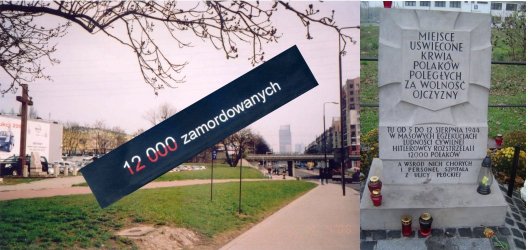
memorial plaque in a place of execution (fot. J. Mankowska)
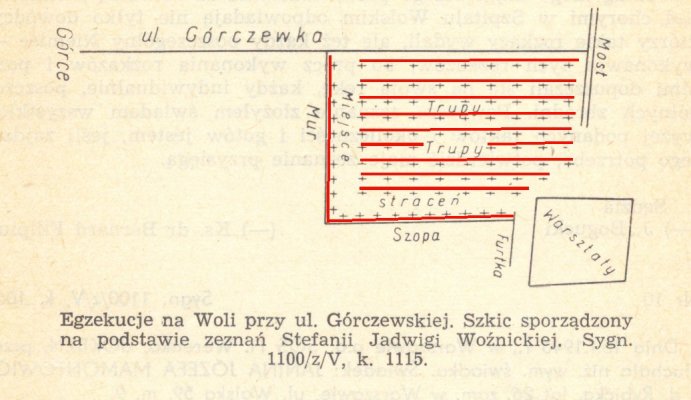
sketch of the execution place
Another relation concerning Wolski Hospital is presented by witness Jan Becwalek:
"We were standing by the gate of the hospital from the side of Gorczewska street. We could hear the sounds of executions in the place from which we got away just a while ago.
In the hospital yard there were buildings - sheds, from which the Germans at some point started to throw out the people who gathered there. They were only men, mostly young, even little boys in the age of 10-12 years, most of them was wearing guerrilla clothes: various uniforms and blouses with armbands - the same in which they had been running in the streets for orders. They must have been closed there for a long time, because they were walking out as if they were drunk or strayed.
The Germans gave them spades and ordered them to dig a pit about 5 meters deep on the other side of Gorczewska street - opposite the hospital gate by which I was standing - in the garden on a potato field. I heard and understood the orders; they brought them near me.
After having dug the pit they were being brought in groups of 25, without shirts, only in pants, with the hands in the air, lined facing the pit and then Ukrainians would kill them with revolvers, shooting in the neck. The bodies would fall to the pit - and the next would be brought. No one screamed, begged or resisted. Several hundred men were killed that way. The last small group of the remaining covered the pit with ground. It was the second execution I had seen that day."
The sick and the women from the staff were led out of the hospital and driven to a makeshift camp in Jelonki. Doctor Zbigniew Wozniewski and a group of almost 100 sick and wounded in a few rooms, omitted in a hurry, together with one Dauthers of Charity nuns and two ward nurses remained in the hospital. The sick were later left in peace and together with the sick and the staff of Karol and Maria Hospital, who came on August 6th and 7th, became the rudiment of a transit hospital for evacuated hospitals and people from other districts and functioned until the end of the Uprising and the expelling the people from Warsaw. Until September 24th also a German first-air station was also situated there. The hospital was wound up on October 28th. The sick were transported outside the Warsaw, mainly to Milanowek and Podkowa Lesna.
In the first days of the uprising the insurgent authorities sent 3 doctors and a team of 15 Polish girl scout-nurses to the St. Lazarus Hospital located two streets away, in the building complex between the streets: Leszno, Karolkowa, Wolska. Since August 1st the hospital was receiving the wounded. Manned with the guerrilla, it found itself on the artillery fire. The sick and the wounded were put in the basements.
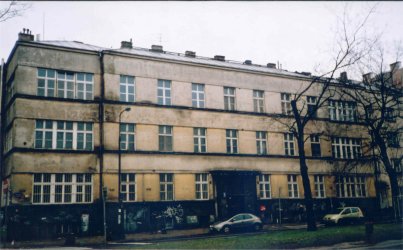
St. Lazarus Hospital (fot. J. Mankowska)
On August 5th, 1944, there were about 300 patients in the hospital, among them over a dozen of Germans, taken prisoners by the guerrilla. In the afternoon the guerrilla was forced out of the object. In the evening the soldiers of one of Ostlegionen group, a part of Dirlewanger's Storm Group heir way into the premises. They were Azeri, former Soviet prisoners, who were part of 111th Regiment's 1st battalion "Azerbaijan" and 2nd battalion "Bergman"; they became infamous for exceptional cruelty during the operations in Wola in the first days of August, 1944. The citizens of Warsaw called them Ukrainians, Mongols, or Kalmyks.
The slaughter of the wounded, the sick, the staff and their families began, as well as that of the citizens of Wola, among whom there were many children, looking for shelter in the hospital. The enemy was shooting with machine guns into the basements through the windows, throwing grenades, and killing the people taken out from the building with the shot in the back of the head. Around 1200 people died in the hospital, some of them burned alive in the building that were set on fire after the slaughter. Thanks to the intervention of the wounded German soldiers who were receiving treatment in the hospital, about 50 people of the medical staff were moved to St. Stanislaw Hospital. Several doctors were killed, as well as around 30 lay and monastic nurses and the nurses from the uprising service, including ten 16- and 17-year-old Polish girl scouts.
Polish girl scout-nurse Wanda Lokietek recalls:
"... Since the early hours of the August 5th, the Germans were attacking our hospital from the side of Wolska street. Around 6 p.m. they entered the premises of the hospital. They ordered the healthy to leave the building, while the severely wounded were left on the beds. We were lined by the wall. There were 15 of us, in the age of 15 to 18. The Germans started to execute the doctors in a beastly way, most often shooting in the back of the head. And so they came to us. They ordered us to move a few steps forward, while they were shooting us in groups. I moved forward together with everyone else, singing "Jeszcze Polska nie zginela..." [Polish anthem - translator's note]. Hearing the shots, I fell down, and so did the girls around me, with their heads dashed...
In the end they took sisters, there were 10 of them, out of the last pavilion. They walked out, reciting "Pod Twoja obrone" [lat. Sub Tuum Praesidium; well-known hymn to Mary]. The Germans shot them one by one. Then they set the hospital on fire, killing the sick on their beds (we heard that story from the one of the sick who hid himself under the bed and survived)..."
Another witness, Wieslawa Chelminska, 14, described the progress of the execution in the basement of the hospital:
"... The civilians and the wounded remained. SS-soldiers started to call a few people a time to the basement. I was called with my mother. After entering, just behind the door I saw a pile of bodies. The electric light was on. A group of SS-soldiers was standing in the corridor with the submachine guns ready to shoot. Me and my mother were ordered to climb the pile. Mother was first and I saw how SS-soldier shot her in the back of the head and how she fell down. I climbed after her and fell down, not waiting for the soldier to shoot. He shot anyway, hitting me in the right arm. Around 20 people had to climb the pile after me before they were shot..."
The next hospital in the way of the death squadrons was the Karol and Maria Hospital, situated at 36 Leszno street. It consisted of 9 pavilions and numbered about 120 beds. It was to be a first-aid station of the "Radoslaw" group formation and the headquarters of the Sanitary Command of Kedyw [Directorate of Diversion]. Since the outbreak of the Uprising the hospital was receiving large numbers of the wounded. Around 150 wounded, including a few Germans, and 60 sick children were staying in the hospital. After a tough battle, on August 6th, 1944, the guerrilla left the hospital. Together with them left the Uprising's sanitary commission, slightly wounded and a few people of the hospital personnel.
After entering the hospital premises, the Germans units threw out most of the personnel to the street, ordering them to leave the wounded and the sick. Some of the wounded were taken away from the buildings, some died when the Germans set the building on fire. The rest of the personnel and the sick children stayed in w farm pavilion of the hospital. The entire group that left the buildings was led by the Germans in the direction of Gorczewska street. In the corner of Mlynarska street they shot a few wounded men, two nurses, the janitor and doctor Kmicikiewicz, who passed himself off as the commandant when Germans ordered that the commandant of the hospital moved forward. Having done that, he probably saved from death other doctors.
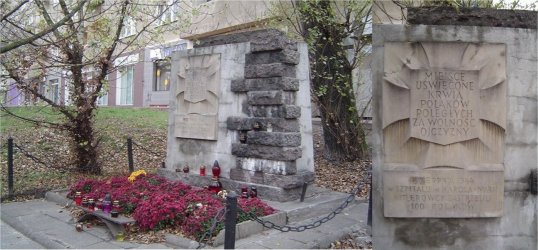
memorial plaque before the Karol and Maria Hospital (fot. M. Janaszek-Seydlitz)
The Germans moved the rest of the people to Wolski Hospital, where doctors and nurses remained, and a part of those who came or were carried here was to be sent back. They were later shot in front of the hospital, having had directed the nurses ward sisters who had been accompanying them to the farm pavilion. The group from this pavilion reached the Wolski Hospital next day. Thirty six children and about 50 sick and wounded were brought to Wolski Hospital. An unknown number of the children ran away in panic in the premises of the hospital. After two days a search team sent from Wolski Hospital found only one child. Another group, of about 60 people, including administrative personnel, was driven by the Germans to Bem's fort, where people from the hospital personnel and the older ones were released.
The next hospital in Wola was St. Stanislaw Hospital at 37 Wolska street. In 1944 it numbered around 600 beds. Already in the first hours of battle, first-aid stations were spontaneously organized in there. On August 3rd, 7 men died on the premises of the hospital during the attack of the German tanks on the barricade ending at the corner of the building. On August 5th the Germans entered the premises through the gate, shooting the man who opened it for them. After throwing out the sick and the personnel to the yard, they began killing them. Ten people died then, including doctor Jan Barch.
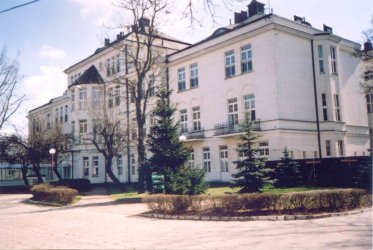
St. Stanislaw Hospital (fot. J. Mankowska)
The vigorous intervention of the doctor Pawel Kubica, who spoke German fluently and managed to explain the Germans that the hospital was of infectious diseases and thus could not give any help or shelter to the guerrilla, stopped the execution. In the first days after capturing the hospital the Germans hanged two guerrilla soldiers on a tree growing in the yard.
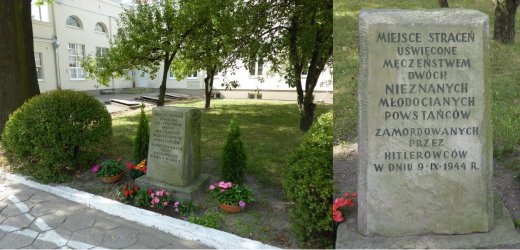
memorial plaque in the premises of the hospital (fot. M. Janaszek-Seydlitz)
St. Stanislaw's Hospital was of great importance for Germans. They organized here a first-aid station for their own wounded soldiers. Two surgeons, Stefan Wesolowski and Leon Manteuffel, who had survived the massacre of the male personnel of Wolski Hospital were assigned by Germans to the hospital personnel in order to treat wounded Germans. Thanks to them, the hospital started to help the wounded, who coming stealthily at night after having had survived the mass-executions, including a few who managed to survive from the slaughter in the Franaszek's factory.
Around August 10th, Standartenführer Oskar Dirlewanger came to the hospital, where he started to live and from where he started to command the operations. Beautiful carpets and silver were brought him from Warsaw houses. In these circumstances there were less murders in the premises of the hospital than in other hospitals of Wola.
Witness doctor Joanna Krynska recalls:
"During the 1944 Warsaw Uprising I was assigned to the AK first-aid station in the St. Stanislaw Hospital. After German units captured the hospital I remained there as a doctor.
Around August 10th, Oberführer Dirlewanger came to the hospital and started to live there. As I spoke German well, I had to perform duties of an interpreter and thanks to that I talked with Dirlewanger and other officers. He commanded the operation in the area of Wolska street and the neighborhood. One day Reinefarth came to the hospital.
Dirlewanger told me that he was a friend of Himmler. In the first part of August 1944, during the conversation with me and doctor Kubica, he said that what was happening in Warsaw with civilians was nothing in comparison with what had been happening in Russia, where his soldiers had left no one alive, killing and raping women.
He said that this was necessary for the victory of Germany, all the more so, as it concerned the nations standing lower than Germans in every aspect. He said that his units were specially trained to crush the guerrilla.
He cooperated closely with Warsaw Gestapo located by the St. Wojciech's church. There was Spilker. Dirlewanger called him a few times to purge the hospital. As a consequence of that German doctors chose several times the severely wounded and young boys, which we were hiding in beds. Having been taken by Gestapo, they were partly transported to St. Wojciech's church and partly disappearing without any information about them.
From the civilians of nearby houses who were staying in the shelters of hospital Gestapo was choosing people by sight or on the basis of denunciations and partly directing them to the camp in Pruszkow, part of these people disappeared without any information about them. There were 3 or 4 of such purges (on Dirlewanger's order).
The Germans also took hospital appliances (microscopes, etc.) and transported them to Germany; the same happened in other hospitals."
Apart from the abovementioned, the places of the August executions in Wola are the following:
- Wolska 180/182 - Wolski Cemetery;
- Wolska 140a - the premises of St. Wawrzyniec's church;
- Wolska 140 - Orthodox church and Orthodox Cemetery;
- Wolska 130/132 - Gen. Jozef Sowinski Park;
- Wolska 105, 107, 109;
- Wolska 81 - the premises of Kirchmajer and Marczewski's factory;
- Wolska 76 - the premises of St. Wojciech's church;
- Wolska 60 - Factory of Pasta and Artificial Coffee Manufacturer "Bramenco";
- Wolska 54 - the premises of Factory of Pasta Manufacturer "Nalecz";
- Wolska 41/45 - the premises of Factory of Pasta Manufacturer "Nalecz";
- Wolska 27/29 - the premises of the monastery of Carmelite nuns;
- M³ynarska 2 - tram depot;
- Górczewska 53 - Boilers Factory "Simplex";
- P³ocka 23,
- Staszica 15,
- Soko³owska 4 (the headquarters of Gestapo);
- Soko³owska 5
and many more.
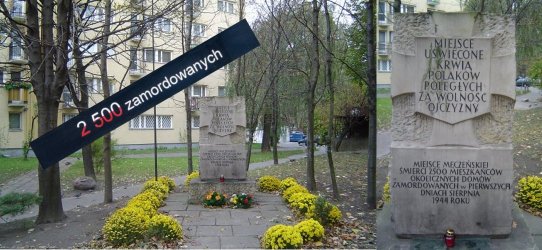 memorial plaque at 102/104 Wolska street (fot. M. Janaszek-Seydlitz) |
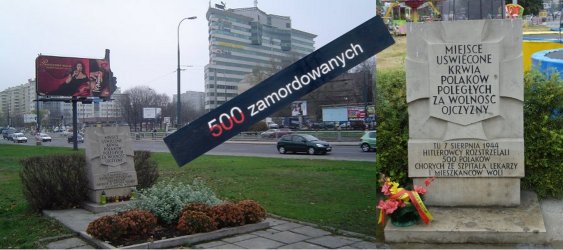 memorial plaque at 2/4/6 Wolska street (fot. M. Janaszek-Seydlitz) |
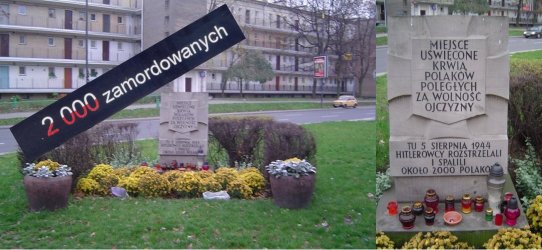 memorial plaque in Gorczewska street, the corner of Staszica street (fot. M. Janaszek-Seydlitz) |
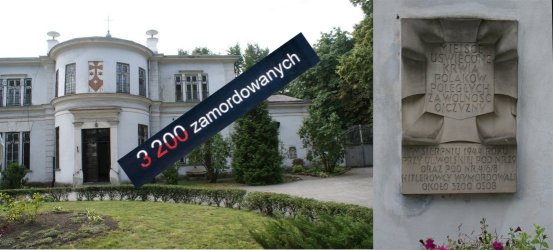 memorial plaque at 27/29 Wolska street (fot. M. Janaszek-Seydlitz) |
Some of these places has been commemorated after the war with memorial plaques and monuments. They can be found on the interactive Remembrance Map. However, the memory of many, from which there were no witnesses, is fading.
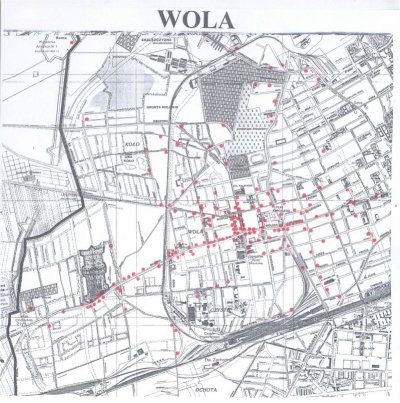
The map of 200 places, where Germans murdered 50 thousand dwellers of the district of Wola during the 1944 Warsaw Uprising.
Created on the basis of the execution sites named on the monument. Edited by: Janina Mankowska
The guerrilla that was fighting in Wola was receiving the information about the massacres of civilians done by Germans in the area, but they had no influence on that. On August 6th Lieutenant Colonel Jan Mazurkiewicz "Radoslaw" informed the AK Commander-in-Chief.
"The enemy is killing the people of Wola, setting more and more houses on fire... A great tragedy is coming, the same as the historic slaughter of Praga... If you can help, do it quickly, there are few hours left... "
On August 5th SS-General Erich von dem Bach-Zelewski, commanding the operation of defeating the Uprising, came to Warsaw. After learning about the situation he issued the order of the partially stopping the slaughter of civilians and the looting of Wola, forbidding the killing of women and children, however not cancelling the order of killing men and captured guerrilla soldiers. The modification of the order of Hitler and Himmler did not stem from the humanitarian reasons. Von dem Bach considered the wide-spread mass-murders caused the excessive use ammo and distract soldiers from their primary objective, that is fighting the enemy. He also took in consideration the economic aspects - The 3rd Reich needed a large number of Polish workers for compulsive work.
In spite of the decision the murders did not stop. Witness Stefan Urlich, 47 years old, gives testimony about exceptionally beastly crime:
"In the first days of the 1944 Warsaw Uprising I was staying in the flat at 56 Bema street... On August 5th or 6th, 1944, German units threw out the civilians from Bema street. I stayed, thanks to the fact that I was working in the kitchen German railway workers in Warszawa Zachodnia Station. A few days after the citizens had been thrown out, on August 8th or 9th, 1944, I noticed that above the gate of the house at 54 Bema street Red Cross flag was hanged, the windows from the side of railway tracks had been boarded up, and in front of the gate I saw groups, of two, three SS-soldiers with Red Cross armbands.
At that time groups of civil population from other districts of Warsaw were escorted to Warszawa Zachodnia Station. SS-soldiers with armbands of the Red Cross were choosing groups of children in the age of 6 to 10, the handicapped, the old and pregnant women from the escorted group, and taking them to the Kosakiewicz's house. I saw that as I was riding a rickshaw to get potatoes for the kitchen... later, I saw that the children were looking through the windows from the side of Bema street in the first floor, and the older in the second floor...
Between 11 p.m. and midnight I heard horrible moans, shouts, and shots coming from the Kosakiewicz's house. It seemed to me that the shots were fired from the Lilpop's premises, located opposite to the number 54. I went out quietly, crawled to a ditch on the side of the railway track. Then I saw that house number 54 was on fire, and at the same time I heard the horrible shouts and curses casted on Germans and children's call: "Mother". No one ran away from the burning house, from this side the windows were boarded up, the door must have been closed. From the side of Lilpop's factory the series of shots were fired; I did not notice what kind of weapon that was. I understood that people are burning alive... "
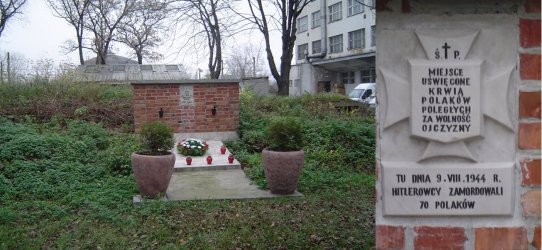
memorial plaque at 57 Bema street (fot. M. Janaszek-Seydlitz)
On August 6th, 1944, Germans executed the civil staff of railway power station in Przyokopowa street, where now the Museum of the Warsaw Uprising is located.
Since August 8th, the killing of civil population was conducted mainly by special units of German police, operating within the group of General Reinefarth, so called Einsatzkommando der Sicherheitspolizei bei der Kampfgruppe Reinefarth, which day after day until the middle of August was murdering civilians, including women and children, on the square at 59 Okopowa street.
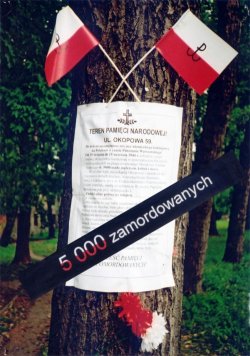
not commemorated place of execution at 59 Okopowa street (fot. J. Mankowska)
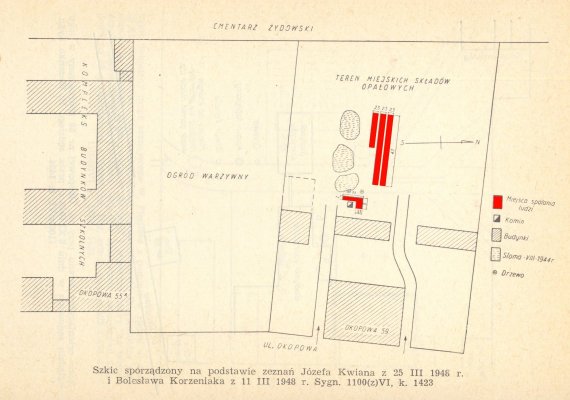
sketch of the place of execution
Apart from that, on August 15th, in the premises of the orthodox and the catholic cemeteries over 2 thousand people were executed, in other cases the number of victims of a single execution did not exceed 200 people.
Since August 11th, 1944, almost the entire district of Wola was occupied by German forces. Among the burned houses of the district lied thousands of bodies of the murdered citizens. The odor of the burned or decaying corpses could be smelled in the air. Germans created the special unit Verbrennugskommando Warschau, whose task was to destroy the traits of the murder. It consisted of a few dozens of strong, young men chosen from Polish prisoners destined for execution. The task of this Commando was to collect the bodies of the murdered and put them on large piles, which were set on fire after having been poured down with inflammable fluid. Over 30 of such piles were set on fire in Wola.
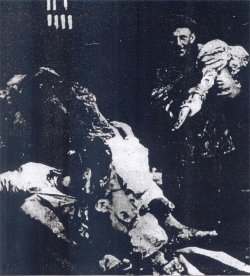 |
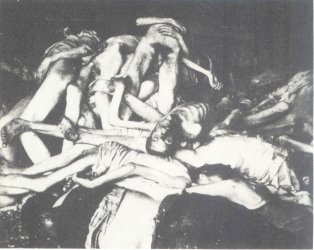 |
The Commando, which was directly subordinated to SS Obersturmführer Neumann, was garrisoned in the building of railwaymen in Sokolowska street, in the closest vicinity of the transit camp for civil population, located in the premises of St. Wojciech's church at 80 Wolska street.
Everyday the prisoners of Commando, equipped with spades, stretches and carts would go, escorted by SS soldiers, to a place of execution. There they would start to "work". Tadeusz Klimaszewski, a prisoner of Verbrennungskommando recalls:
"The Franaszek's factory... A horrible, unbearable odor reached us. As far as one could see, there was a square filled with bodies. They were lying in the full sun, some gathered in the middle in groups, and some that were lying away stretched near each other, and another, single ones, lying in the back of the yard with the hands extending in the direction of the wall, as if in the last attempt to survive. They must have been, driven into the court and squeezed in the crowd, thrown grenades at, because tangled bodies were awfully massacred, and the yard was full of holes and pits. The others from the crowd, who were not instantaneously reached by death, were lying in disorder, cringed in fear or in pain...
This mass-murder must have been conducted a few days ago, because the August sun had already distended the bodies. Thousands of fat flies were swarming on the black stains of clotted blood...
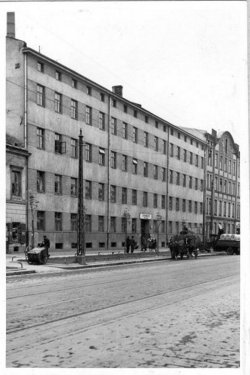 |
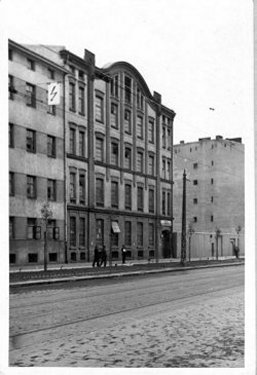 |
buildings of Franaszek's Factory

memorial plaques at 43/45 in the place of Franaszek's factory (fot. M. Janaszek-Seydlitz)
We were standing motionlessly. A sudden sob, unstoppable, convulsive broke the silence. It was an engineer who was crying like a baby...
" - People, people, do not take them... Leave them, let them lie. The war is ending, let the others watch, let them see... They have to lie here! We will bring people from all over the world here, let them see!"
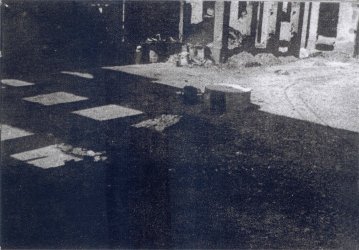 |
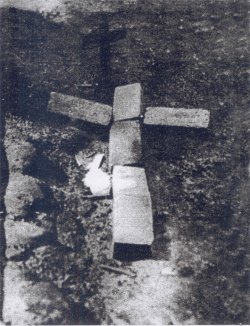 |
temporary place of burying the human ashes in the Franaszek's factory
It was not the only one place that was so horrifying. Tadeusz Klimaszewski also recalls:
"... We were surprised that on Wolska street we were turning in the direction opposite to the city. It was the area of suburban gardens, small fields, gardener's property. Behind them wreathed the lush green of cemeteries, which the towers of churches were emerging from: the orthodox and Wolski.
... Beneath the leaves there was a blackened human corpse, and another, and another, there were many of them. They filled the whole corner of the garden, tangled in disorder with the green of bushes. It was not until then that we had noticed that the leaves around were crumpled and stained with reddish stains of blood...
We moved closer and looked inside a dark hole, but instead of water we saw squeezed bodies, contorted horribly... There were corpses everywhere... They could not have only been the people of this house or the neighboring one. People from the vicinity or from the big house towering on the opposite side of the street. Among the dead there were mostly the bodies of men...
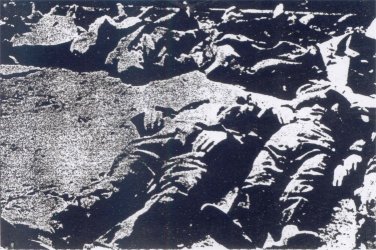 |
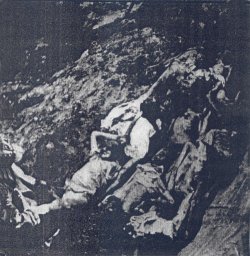 |
After cleaning the area of the well and the yard, we went to the other side of the garden. Walking along the short fence wall, densely raked with bullets, suddenly we found a new heap of the dead. It must have been a group of refugees. What seemed to prove that were the clothes of the murdered, the overcoats and coats they were wearing, and bundles, packages, suitcases scattered around. In this place there were mostly women and children. Small children and babies were still lying in clenched by cramp embraces of their mothers, the older ones were lying nearby holding in hands their clothes.
In the middle of this group, an old, grey man was lying like some kind of ghostly symbol. His hand was protruding far ahead, clenched stick, leaning on the bodies lying nearby, at the end of the stick a white flag was flattering.
There were traits of robbery everywhere... arms had been brutally convoluted, injured by rapacious fingers that had been taking rings and signet rings off..."
Verbrennugskommando conducted its actions mainly on the line of streets: Wolska, Chlodna, Elektoralna, Bank's Square, turning into streets: Plocka, Dzialdowska, Mlynarska, Karolkowa, Towarowa, Krochmalna, Zelazna, Orla, Zimna, Przechodnia, and Zabia. It also collected the murdered in the area of Hale Mirowskie [large trade halls in Warsaw].
The piles created with bodies of victims from Wola were burning in many places. Germans wanted chiefly to erase the evidence of crime The ashes of the burned bodies would be buried in the premises of so called "Wenecja" [Venice], an empty square after carousels, funhouses, Ferris wheels and cabinets of curiosities, located in the vicinity of the contemporary Wola Department Store.
The prisoners of Kommando had to give Germans all the gold and valuables found with the bodies, as well as report about finding someone alive. Not obeying the order resulted in death. Part of the collected valuables was simply stolen by SS-soldiers.
Verbrennungskommando Warschau was operating at least until the middle of September 1944. A few prisoners managed to escape and get through to the territory still occupied by the guerrilla. Due to this fact they could later tell about the unimaginable massacre of Wola, which they had witnessed. The rest shared the fate of those whom they had been burying on martyred land. Germans did not have in custom leaving the witnesses of their crimes.
St. Wojciech's church at 74/76 Wolska street inscribed itself deeply into the memory of many citizens of Warsaw. On its territory Germans organized an assembly point for the part of the population of Wola who had survived the pogrom. Already on August 2nd military police came to presbytery and conducted a search combined with robbery. On the next day Gestapo was garrisoned there. Priests were forbidden to perform religious ministries. The command over the transit camp in St. Wojciech's church was taken by SS Hauptsturmführer Alfred Spilker from Warsaw Gestapo.
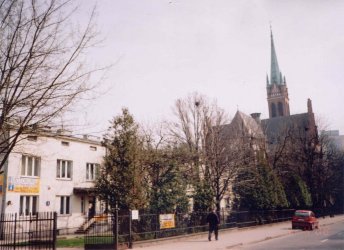
the presbytery of St. Wojciech's church at 4 Sokolowska street (fot. J. Mankowska)
Priest Waclaw Murawski recalls:
"The outbreak of the 1944 Warsaw Uprising found me in the presbytery at 4 Sokolowska street in Warsaw. I was there, as I am also now, the parish priest of St. Wojciech's parish in Wola... After the first shots in the neighborhood of the church, on August 1st, 1944, at 5 p.m., the whole yard filled with armed German sappers... Since that day I would walk only under the escort...
In the evening of August 2nd, 1944, a unit of military police came to the presbytery... I noticed that they had badges fastened to their uniforms on the level of the pockets with the inscription "Posen" on black background... They repeatedly conducted a search of presbytery, taking valuable things and even linen... Before noon of August 2nd, 1944, a group of civilians from the closest vicinity of Wolska street, from the area from Plocka to Bema street, was brought to the church by another unit of military police. These people told me that military police would storm into their houses, throw grenades into basements, and throw out people. The houses were not on the fighting line.
Already since August 3rd, 1944, groups of people were started to be sent away from Warsaw to transit camps in Ursus, and later to Pruszkow. On August 3rd and 4th, 1944, came the groups of people, mostly women and children, from Wolska street and cross streets from the section from Mlynarska to Bema street.
I heard from many women that in those days and on that section Germans - from military police, and "Ukrainians", were killing the majority of men, and sending women to the church...
On August 5th, 1944, Gestapo came to the presbytery... All of them were wearing uniforms and I noticed that they had Totenkopf's on the caps and lapels of uniforms... After they arrived, I was forbidden to go to the church... Opposite the presbytery, at 5 Sokolowska street, groups of men brought from the city or led out from the church were kept since August 2nd, 1944. They were sometimes used to take apart barricades.
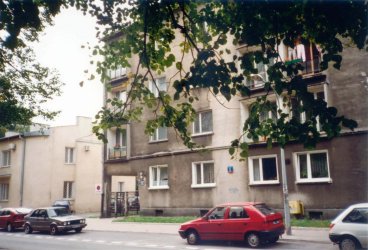
headquarters of Gestapo and Verbrennungskommando at 5 Sokolowska street (fot. J. Mankowska)
Since August 3rd, 1944, some of these men were led out in groups and they disappeared... Since August 5th, 1944, the number of groups of people that were coming increased considerably, there were days when the church was overcrowded, with 5 thousand people inside. At the same time there were often transports to the transit camp in Pruszkow... Apart from me, priests Stanislaw Kulesza, Stanislaw Maczek, and Roman Ciesialkiewicz were staying in presbytery. On August 8th, 1944, Gestapo soldiers took these three priests... they were taken to the house at 5 Sokolowska street, where they were taken in cars from. After the war, a woman, whose name I do not remember, told me that she saw that all three priests from my parish were shot by Germans in Moczydlo street...
On August 9th, 1944, after going into the church, I saw that there were around 5000 people inside. They came from streets: Elektoralna, Chlodna, Leszno, and others... In the chancel woman in childbirth were lying, there were a few babies, the sick were lying on the floor... The people were not allowed to leave the church even to relieve themselves..."
Over 5 thousand people from the vicinity stayed in the church every day. Inside the temple, in an enormous crush, without water or food, stayed the old, women and children; men were kept outside and in the lower church and after selection assigned to take apart barricades, to camps or for execution. After the fall of Wola, also people from other, in turn captured by Germans, districts of Warsaw were sent to the camp in St. Wojciech's church.
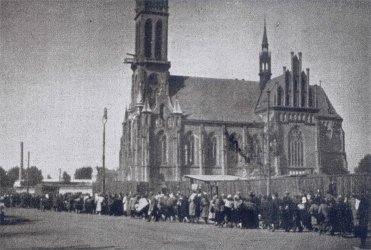 |
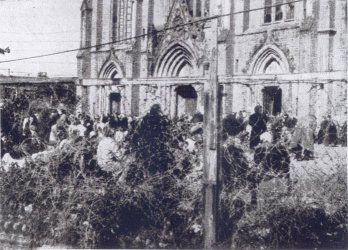 |
civilians driven to St. Wojciech's church
Fourteen-year-old Polish girl scout from Wola, Irena Janowska "Inka", who at the moment of the outbreak of the Uprising was at an assembly at 3 Ksiazeca street, and then found herself in the middle of guerrilla fights far from her family, recalls:
"... I was running with my friends along Ksiazeca and Nowy Swiat streets, then we parted. On the Pilsudski's Square I was stopped by Germans and driven into the tenement house at 6 Krolewska street, where I stayed for three weeks... Then I was driven together with the inhabitants of that house and others through the burning city into the unknown...
We are walking from the Pilsudski's Square in a long, guarded by Germans column. As we leave the Saxon's Garden we are attacked by a crew of Vlasov soldiers, who were snatching in a scuffle the bundles and all they could. Near Hale Mirowskie there are shots, screams, and despair again - here Ukrainians pulling out young girls from the column and take them into the ruins... We reach Mlynarska street.
Here we are again attacked by Ukrainians. One of them runs up to me and pulls my ears, trying to rip the golden earrings. My sharp scream calls in a guard, who hits the Ukrainian with the butt of his rifle and pushes him away from me.
In the dust and smell of burning houses and human bodies we reach St. Wojciech's church. I find myself close to my home. I have already learned about the inhuman massacre of people of Wola. I am terrified and in despair. What happened with my family? I am a child, was I left alone in this abyss of crime?
In the court of the church stands a bucket with water. People force their way to it, but there are no mugs. Someone has a small mug. A woman wants to give a golden ring for giving her this dish. I am also dying of thirst, but I do not drink...
We are driven into the church. People are tired and fall down on the cold floor as if they were logs of wood. A German sentry stands at every door. There are two large holes in the ground near the church, which are supposed to be toilets. Everyone is suffering hunger.
Germans confiscate all the valuable things the people possess. Horror reigns. What will happen next? In this odor and dirt, amid the moans, cries and prayers I spend a horrible night.
In the morning SS soldiers storm into the church and look around at the people, choosing already selected young ones. Same as yesterday on the Pilsudski's Square, when they chose me together with four other children to play the role of "human shields" to protect Germans searching the houses and ruins left by the guerrilla in Krolewska street.
Now I hear the same words: - Du! Du! Du!... And again I see a large finger in front of my face. - Du! - decides the German - My God! Why me again? - I think w anxiety. We are We are led out from the church and load on a truck. There are also boys. No one says anything. We are taken to Okopowa street to a tannery. We are carrying tans out and load them onto the trucks for the whole day. Before evening girls return to the church, boys do not. Their destiny is unknown. After leaving the tannery I heard shots and explosions. I could also see flames. The factory was blown out.
In the church I do not see the people I was brought here with. There are new ones. I am very hungry. Despite the tiredness, I cannot sleep. It is very cold lying on the stone floor in the silk dress. So passes the second night in the church. The rays of sun get through the windows. SS soldiers come again. They are shouting and pushing brutally the old and the sick, the throw us out of the church. A column is formed, which is then driven by Germans along the streets of Wola to Warszawa Zachodnia Station. They force us into the cattle cars and shut the doors. The train moves. For me, to another compartment of Hell..."
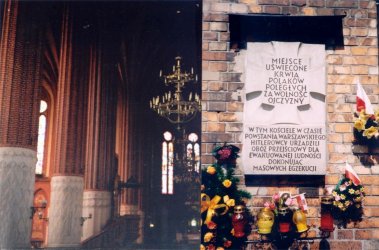
the interior of St. Wojciech's church and a memorial plaque on its wall (fot. J. Mankowska)
For a few weeks Germans were sending columns of Warsaw citizens to the church, performing numerous executions in the way. In front of the church German "experts" would choose young people who in their opinion looked like the guerrilla soldiers or who were suspected to have Jewish origins. Jews were led on the side and killed. The men suspected of being a part of the AK were driven for interrogation to prison and then sent to concentration camps, some young, healthy men were left to work in Warsaw. After a short rest, the remaining men, women, children and the old were driven on foot to Warszawa Zachodnia Station and from there in trains to the camp in Pruszkow.
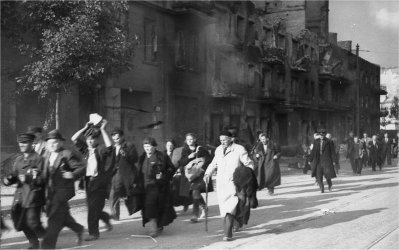 |
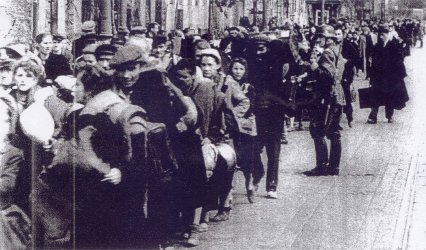 |
exodus of the dwellers of Warsaw
Doctors, who turned out to be among the evacuated people, organizer a simple infirmary in the chancel near the main altar; they collected bandages and medicaments from the people in order to be able to help the sick and the wounded.
The camp in St. Wojciech's church existed until the end of the Uprising. In the area of the church there were the executions of guerrilla soldiers taken into captivity. About 90 thousand citizens of Warsaw went through this camp.
The second historic church of Wola - St. Wawrzyniec's church in Reduta Wolska was not only the place of the murder of the heroic parish priest, priest captain Mieczyslaw Krygier, guerrilla soldiers, and civilians. Here died also pregnant Janina Franaszek, the wife of Kazimierz Franaszek, the owner and the director of factory. She was murdered together with her 5-year-old son, Piotr.
St. Wawrzyniec's church played a similar role, although on a smaller scale, as St. Wojciech's church. Also in this church Germans kept civil population of Warsaw, later driven on foot to the camp in Pruszkow. The church was partially burned. The interior of the church suffered severely, because Ukrainians had fun shooting to the statues of saints and to paintings.
Bohdan Honda, born in 1944, domiciled in Wlochy, talks about the drama of the people of Wola:
"Sixteen members of my closest family died in Wola, including a cousin who was a guerrilla soldier. He died in Wola. No one knows where he is buried. We knew about it, because our grandmother could not endure it and at the end of the August or at the beginning of the September, she went out of our house. She went to Wola to search for family. She had two daughters and three sons with families. From father's side died: mother, sister with husband... etc. 16 people in total.
A week later she returned with a Job's news. She went through all their homes. Empty. She got caught and taken to St. Wojciech's church when Germans had practically finished the executions and burning of corpses in Wola. In St. Wojciech's church there was a detention station - she ran away from there. And came here a week later.
From what she saw, from what she looked at, she knew that there was no chance, no hope for them to return. She lost her mind. She did not find anyone. She found only empty houses, empty areas.
From the stories in the church it seemed that the entire areas of streets and buildings had been looted, and the people thrown out to Wolska street in front of the positions of machine guns. The bodies had been burned in Gen. Jozef Sowinski Park.
A man, who had run away from under a pile of bodies in Gen. Jozef Sowinski Park, came to my father. He told my parents what had happened, and I was listening to it. They had threw thee living and the dead on a pile, poured them with gas and set on fire. To say "slaughter" is not enough!!!..."
Wola received the first blow of the Germans forces suppressing the Uprising. After the capitulation of the Uprising and expelling the entire population of Warsaw, Wola shared the fate of other districts. When on January 17, 1945, Soviet forces and Polish Army that was accompanying them saw in Wola only burned stumps protruding from under the snow. Here and there blackened not fully burned remains of bodies.
On November 25th, 1945, the Cemetery of Warsaw Insurgents in Wola. The area of 1.5 hectares has been situated on the exterior side of the Wolski Cemetery at 174/176 Wolska street. The bodies of Warsaw victims of the II World War, collected from lawns, squares and streets started to be buried there. Between the cemeteries of Wola in Sowinskiego street a large line of the crates put vertically in several layers was created; they contained the remains found in the streets of Warsaw.
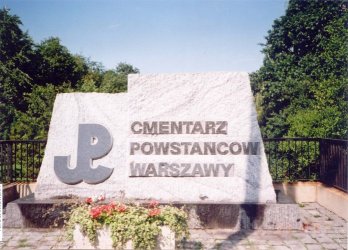
Warsaw Insurgents Cemetery (fot. J. Mankowska)
Two graves of one son
- To the Mothers fallen in the Uprising
Warsaw free! - how sneeringly
resounded the news,
Free from Germans, But did it live?
The stumps of houses from ruins emerged,
With scattered corpses the city was filled,
In hundreds the thousands were changed
Charred, incinerated or in the skull struck!
From ruins and lawns here they were brought.
In openwork cases powdered with lime
In lengthy ranks
The battle line was formed,
To fill the mass graves
For eternal glory's sake!
WOLA - most of all smitten,
Cemetery of Fallen Unconquerable formed,
Of courageous heroes
And city dwellers
Inhumanely exterminated
To a greater cause all dedicated!
Most of the heroes are but "unknown",
Only few got to be known.
Over a grave,
Hunched, faded woman was standing.
Though she said nothing,
It seemed that in the grave
Was all she had ever possessed.
And in such deathly silence, abyss of despair,
Up to that woman walked
Saved from this fire -
A little girl,
Who touched her hand softly
And asked:
- Does he is buried here,
Your Son so dear?
Then the woman her weeping eyes
Immersed in a distance
And almost soundlessly whispered:
- Yes. - No. - I don't know...
- I was seeking all over,
I asked questions, identified...
- Maybe here, maybe in Powazki...?
I believe one of these graves
has taken my son.
- I will them both equally revere
I will still believe that one or the other
Hid my son so dear,
Though I don't know
Whether he's here?
- He was so young,
Of Poland enamored,
Merciless for enemy,
In Homeland absorbed.
And so she remained
Torn apart and almost deceased,
Mother of a Warsaw insurgent
And of her desperate faith
The son's grave!
Janina Janowska
Warsaw 1958
a poem based on the authentic event during setting up the cemetery
in November 1945, which the author of the poem took part in when she was a little girl
On August 6th, 1946, a stirring procession set out to the Cemetery of Warsaw Insurgents. Over 8.5 tons of human ashes of those burned on stakes spread all over Wola, in the area of Pawiak [infamous prison], from the territory of former Jewish Ghetto and the yard of former headquarters of Gestapo in al. Szucha avenue were carried in 117 coffins.
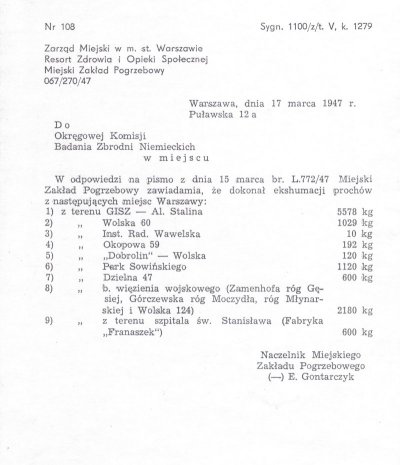 |
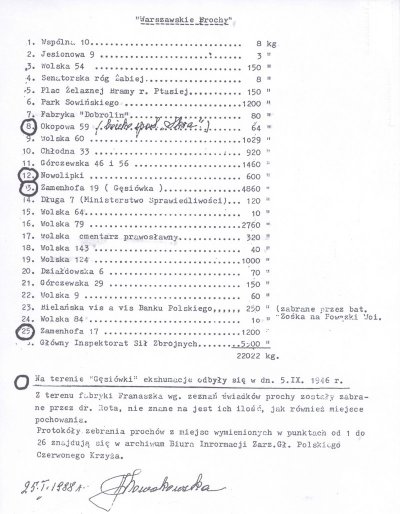 |
documents containing the specification of human ashes
In 177 mass graves the remains of over 40 thousand of victims of Hitlerism were buried here: unknown Polish soldiers of 1939 and soldiers of Polish 1st Tadeusz Kosciuszko Infantry Division who fell in battle of Warsaw in 1944 and 1945, guerrilla soldiers from various formations, civilians. In a separate place rest the remains of 6,588 Jews executed in years 1940-1943 on the sports field of "Skra" in Okopowa street.
In the central part of the cemetery tumulus is located, which contains 12 tons of human ashes. In 1973 the monument "Polegli Niepokonani" [The Fallen Unconquerable] designed by professor Gustaw Zemla was placed the tumulus. It presents a dying fighter with his chest ripped, who leans on the hand wielding a sword and raises the other hand holding a shield; this symbolizes the fight of the Warsaw soldiers for freedom.
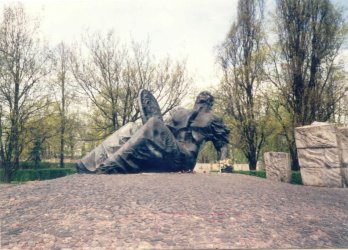 |
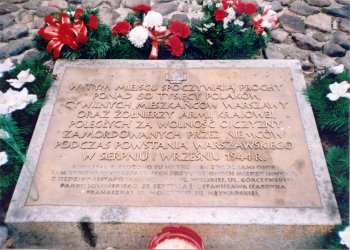 |
The monument "Polegli Niepokonani" on the tumulus and a memorial plaque (fot. J. Mankowska)
The remains of around 104 thousand people are buried at the cemetery of Warsaw Insurgents.
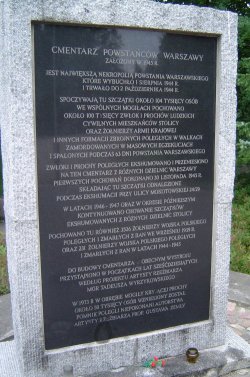
memorial plaque illustrating the number of victims (fot. M. Janaszek-Seydlitz)
A few years ago two monuments were unveiled in Wola, which commemorate the martyrdom of its people. The first monument, dedicated to the Martyrs of Warsaw's Wola [Meczennikom Warszawskiej Woli], was erected in the court of the Redemptorist Church at 49 Karolkowa street.
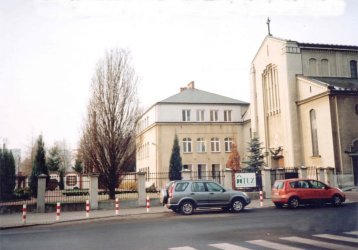 |
 |
The Redemptorist Church (fot. J. Mankowska) and the complex of Memorial Plaques (fot. M. Janaszek-Seydlitz)
The second, the main one, unveiled in the autumn of 2004 stands in the square at the junction of Leszno and al. Solidarnosci streets. It has the following inscription: "Pamieci 50 tysiecy mieszkancow Woli zamordowanych przez Niemcow podczas Powstania Warszawskiego 1944 roku" ["To the memory of the people of Wola murdered by Germans during the 1944 Warsaw Uprising."].
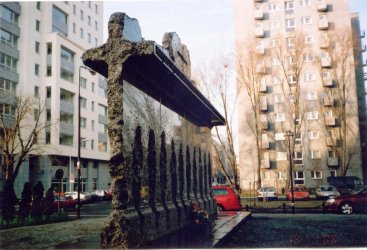
the monument commemorating the memory of 50 thousand dwellers of Wola, in Leszno street, corner of al. Solidarnosci street (fot. J. Mankowska)
What happened in Wola in that August can be reconstructed only partially on the basis of the testimonies who survived this. There were many places of executions with no survivors. Only the memories of piles of the dead remained. Germans tried to erase all the evidence of the crime by burning the bodies.
In order to grasp the magnitude of the crime committed by Germans on the helpless people who lived in Wola let's imagine that the murdered victims formed a gigantic queue in the streets of Warsaw. The head of the queue starts by the Cemetery of Warsaw Insurgents. Then this shadow procession goes along Wolska, Al. Solidarnosci to the Bank's Square, Marszalkowska to Unii Lubelskiej Square, and then along the longest Warsaw street - Pulawska to the number 560 (the corner of Kuropatwy street), the south border of Warsaw. The length of such queue amounts to about 20 kilometers.
The history of the slaughter of Wola has not been presented in many studies. If something has been written about the August 1944 in the district, it usually focused on the fighting guerrilla. However, since a few years the memory of genocide stirs up more and more interest of society, also thanks to the opening of the Museum of the Warsaw Uprising. Initiative group in the following panel: Jerzy Janowski, Janina Mankowska, Marta Olejnicka started the civil initiative to proclaim the day of August 5th the Day of Wola.
As a result of this initiative on December 8th, 2009, at XLV Session the Council of Wola District took its stand in the matter of proclaiming the day of August 5th Ogolnowarszawski Dzien Pamieci Mieszkancow Woli murdered by Germans during the Warsaw Uprising and enter this date into the annual c of the Uprising. On December 28th, 2009, letter concerning this matter was submitted to the President of Warsaw, Hanna Gronkiewicz-Waltz.
On July 15th, 2010, the City Council of Warsaw adopted the resolution that August 5th should be celebrated as the Ogolnowarszawski Dzien Pamieci Mieszkancow Woli zamordowanych przez Niemcow w czasie Powstania Warszawskiego.
compiled by:
Janina Mankowska
Jerzy Janowski
Maciej Janaszek-Seydlitz
translation: Pawel Boruciak
Copyright © 2011 Maciej Janaszek-Seydlitz. All rights reserved.